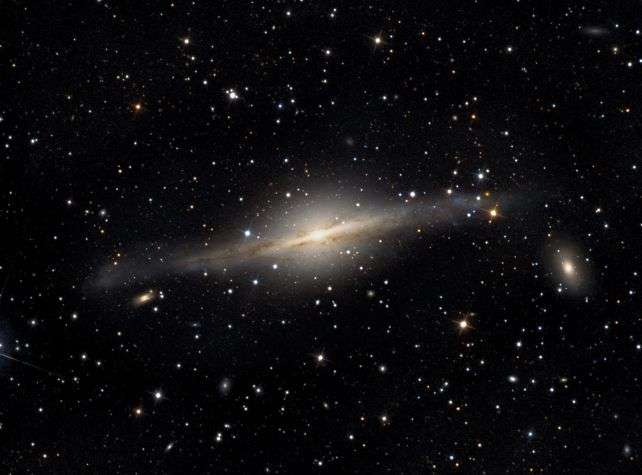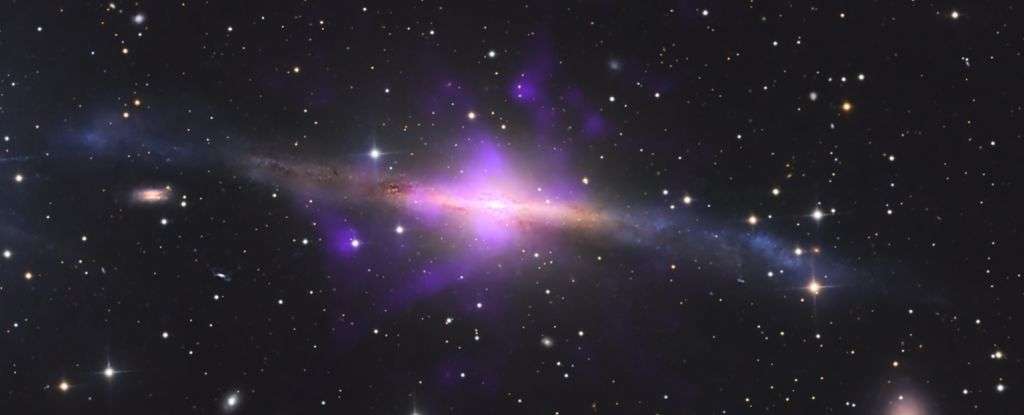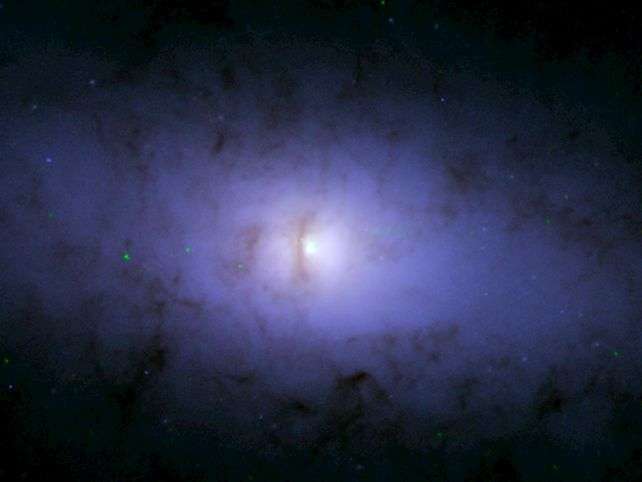Discovery of ‘Sideways’ Black Hole by SAUNAS at the Center of NGC 5084
A recent astronomical discovery has revealed a supermassive black hole in the galaxy NGC 5084, located approximately 80 million light years away from Earth, tipped onto its side. This peculiar orientation has sparked intrigue among scientists, as it challenges existing understandings of black hole behavior and galaxy dynamics.
It could be likened to the Uranus of black holes, leaving astronomers puzzled about how it ended up in this peculiar state—particularly given that existing evidence indicates it may not have always been aligned as we observe it today.
The Discovery of NGC 5084
NGC 5084 has been a subject of study for centuries. Cataloged by William Herschel in 1785, it is classified as a lenticular galaxy located about 80 million light-years away in the constellation Virgo (which lies between spiral and elliptical galaxies). NGC 5084 spans over 200,000 light years and contains an estimated mass equivalent to 1.3 trillion suns, making it one of the largest lenticular galaxies known.
Despite its size, the supermassive black hole at the center of NGC 5084 has remained somewhat enigmatic due to the galaxy’s edge-on orientation, which complicates observations of its core. The center is also obscured by bright dust, making it challenging to study.

Understanding Supermassive Black Holes
Supermassive black holes are colossal entities found at the centers of galaxies, characterized by masses ranging from hundreds of thousands to billions of times that of our sun. They possess such immense gravitational pull that not even light can escape their grasp.
The boundary surrounding a black hole is known as the event horizon, which is directly proportional to the black hole’s mass. At the core of a black hole lies a singularity, a point of infinite density where the laws of physics as we know them cease to function.
-
The Accretion Disc and Jets
The material surrounding a black hole does not simply get sucked in; instead, it forms a rotating disc due to the conservation of angular momentum. As matter spirals inward, it generates immense friction, heating the material to extreme temperatures and emitting radiation across the electromagnetic spectrum, particularly in the X-ray and extreme ultraviolet wavelengths.
Typically, powerful jets of highly energetic particles are ejected from the poles of the black hole, perpendicular to the accretion disc and the galactic plane. However, the recent findings regarding NGC 5084 challenge this conventional understanding.
Tipped Supermassive Black Hole
The discovery of this sideways black hole was not straightforward. Researchers from NASA’s Ames Research Center in California employed a new technique called SAUNAS, which stands for Selective Amplification of Ultra Noisy Astronomical Signals. It enables astronomers to tease out low-brightness X-ray emissions that were previously drowned out by other radiation sources.
Led by astronomer Alejandro Borlaff of the NASA Ames Research Center, a team of scientists found archival observations could be tapped to find out more about the galaxy’s core. When the team put their new technique to the test by combing through old archival data from the Chandra X-ray observatory – a space telescope that acts as the X-ray counterpart to Hubble’s visible-light observations – they found their first clue that something unusual was going on in NGC 5084. They found four long plumes of X-ray-emitting plasma extending from the galactic center in an X-shaped formation.

These plumes are indicative of past activity at the black hole, suggesting that it has been actively consuming matter from its surroundings. Not all material consumed by a black hole disappears beyond the event horizon; some is redirected along magnetic field lines to the poles, resulting in jets of plasma being ejected into space.
The Tipped Orientation
The researchers noted that two of the X-ray plumes were aligned with the galactic plane, while the other two were embedded within the galactic disk. This discrepancy led to the hypothesis that the supermassive black hole was once oriented normally but has since tipped sideways, akin to the planet Uranus.
To further investigate, the team analyzed additional archival data from various telescopes, including the Hubble Space Telescope and the Atacama Large Millimeter/submillimeter Array. They also conducted new observations from the Apache Point Observatory. This comprehensive approach allowed them to piece together a clearer picture of the galaxy’s history.
“It was like seeing a crime scene with multiple types of light,” Borlaff says. “Putting all the pictures together revealed that NGC 5084 has changed a lot in its recent past.”
The findings confirmed the presence of the jets and revealed a band of dust, characteristic of the disk of material swirling around the black hole’s equatorial region. However, this dust was found to be oriented perpendicularly to the galactic plane, reinforcing the idea that the black hole is indeed tipped on its side.
This implies a fascinating occurrence in the galaxy’s history that may have led to a significant inflow of material toward the galactic center. Such an event could involve a merger with another galaxy, which also possessed its own supermassive black hole, ultimately culminating in a collision and the merging of the two supermassive black holes.
Borlaff’s coauthor and astrophysicist at Ames, Pamela Marcum, added that “detecting two pairs of X-ray plumes in one galaxy is exceptional. The combination of their unusual, cross-shaped structure and the ‘tipped-over,’ dusty disk gives us unique insights into this galaxy’s history.”

This discovery by SAUNAS highlights its ability to breathe fresh life into older data, revealing unexpected findings in well-known galaxies. This intriguing revelation about a galaxy first observed in 1785 inspires optimism that further unusual and fascinating discoveries may await, even in regions we believed to be thoroughly explored.
Challenges to Existing Models
The discoveries made by Hubble and Chandra have posed significant challenges to existing black hole models. Observations of supermassive black holes at the centers of galaxies have revealed unexpected behaviors and characteristics, prompting scientists to re-evaluate their theories and develop new models to explain the complex dynamics at play. Additionally, the detection of intermediate-mass black holes has filled a crucial gap in our understanding, bridging the divide between stellar mass and supermassive black holes.
Conclusion
For the first time, researchers have determined the mass of this supermassive black hole, clocking in at 45.7 million times that of the sun. While more research is needed to pinpoint the exact event that caused this tipping, the discovery provides unique insights into the dynamic nature of black holes and their interactions within galaxies.
It’s just astonishing to think that, after gazing at this galaxy for centuries, this is the first time we’ve discovered these shenanigans going on inside NGC 5084.
This research has been published in the Astrophysical Journal, marking a significant advancement in our understanding of cosmic phenomena.